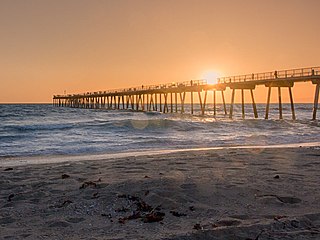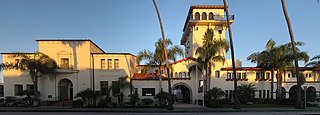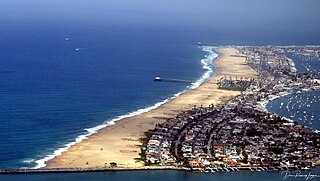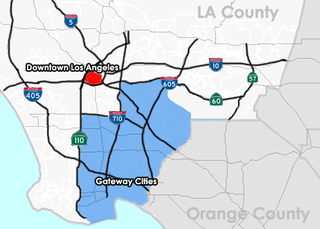Related Research Articles

Orange County, often known by its initials O.C., is a county located in the Los Angeles metropolitan area in Southern California, United States. As of the 2020 census, the population was 3,186,989, making it the third-most-populous county in California, the sixth-most-populous in the United States, and more populous than 19 American states and Washington, D.C. Although largely suburban, it is the second-most-densely-populated county in the state behind San Francisco County. The county's three most-populous cities are Anaheim, Santa Ana, and Irvine, each of which has a population exceeding 300,000. Santa Ana is also the county seat. Six cities in Orange County are on the Pacific coast: Seal Beach, Huntington Beach, Newport Beach, Laguna Beach, Dana Point, and San Clemente.

Southern California is a geographic and cultural region that generally comprises the southern portion of the U.S. state of California. It includes the Los Angeles metropolitan area and also the Inland Empire. The region generally contains ten of California's 58 counties: Imperial, Kern, Los Angeles, Orange, Riverside, San Bernardino, San Diego, Santa Barbara, San Luis Obispo and Ventura counties.

Huntington Beach is a seaside city in Orange County in Southern California, United States. The city is named after American businessman Henry E. Huntington. The population was 198,711 during the 2020 census, making it the fourth most populous city in Orange County, the most populous beach city in Orange County, and the seventh most populous city in the Los Angeles-Long Beach-Anaheim, CA Metropolitan Statistical Area. Located 35 miles (56 km) southeast of Downtown Los Angeles, it is bordered by Bolsa Chica Basin State Marine Conservation Area on the west, the Pacific Ocean on the southwest, by Seal Beach on the northwest, by Westminster on the north, by Fountain Valley on the northeast, by Costa Mesa on the east, and by Newport Beach on the southeast.

Greater Los Angeles is the second-largest metropolitan area in the United States, with a population of 18.5 million in 2021, encompassing six counties in Southern California extending from Ventura County in the west to San Bernardino County and Riverside County in the east, with Los Angeles County in the center, Kern County in the north, and Orange County to the southeast. The Los Angeles–Anaheim–Riverside combined statistical area covers 33,954 square miles (87,940 km2), making it the largest metropolitan region in the United States by land area. The contiguous urban area is 2,281 square miles (5,910 km2), the remainder mostly consisting of mountain and desert areas.

Manhattan Beach is a city in southwestern Los Angeles County, California, United States, on the Pacific coast south of El Segundo, west of Hawthorne and Redondo Beach, and north of Hermosa Beach. As of the 2020 census, the population was 35,506.

Seal Beach is a coastal city in Orange County, California, United States. As of the 2020 census, the population was 25,242, up from 24,168 at the 2010 census.

The Pacific Electric Railway Company, nicknamed the Red Cars, was a privately owned mass transit system in Southern California consisting of electrically powered streetcars, interurban cars, and buses and was the largest electric railway system in the world in the 1920s. Organized around the city centers of Los Angeles and San Bernardino, it connected cities in Los Angeles County, Orange County, San Bernardino County and Riverside County.

Henry Edwards Huntington was an American railroad magnate and collector of art and rare books. Huntington settled in Los Angeles, where he owned the Pacific Electric Railway as well as substantial real estate interests. In addition to being a businessman and art collector, Huntington was a major booster for Los Angeles in the late 19th and early 20th centuries. Many places in California are named after him.

The Irvine Company LLC is an American private company focused on real estate development. It is headquartered in Newport Beach, California, with a large portion of its operations centered in and around Irvine, California, a planned city of more than 300,000 people mainly designed by the Irvine Company. The company was founded by the Irvine family and is currently wholly owned by Donald Bren.

Balboa Island is a harborside community in Newport Beach, California, accessible to the public via bridge, ferry and several public docks. The community is surrounded by a paved concrete boardwalk open to pedestrian traffic, designated as a public walking trail by the city.

The Balboa Peninsula is a neighborhood of the city of Newport Beach, Orange County, California. It is named after Spanish explorer Vasco Núñez de Balboa, the first European to sight the Pacific from the Americas. Balboa is primarily residential with some commercial areas.

The Gateway Cities Region, or Southeast Los Angeles County, is an urbanized region located in southeastern Los Angeles County, California, between the City of Los Angeles proper, Orange County, and the Pacific Ocean. The cluster of cities has been termed "Gateway Cities" in that they serve as a "gateway" between the LA and Orange counties, with the city of Cerritos equidistant from Downtown L.A., Long Beach, and Santa Ana in Orange County. As such, the area is central to the Los Angeles-Long Beach-Anaheim, CA Metropolitan Statistical Area (MSA), and has a population of approximately 2,000,000 residents.

Mediterranean Revival is an architectural style introduced in the United States, Canada, and certain other countries in the 19th century. It incorporated references from Spanish Renaissance, Spanish Colonial, Italian Renaissance, French Colonial, Beaux-Arts, Moorish architecture, and Venetian Gothic architecture.

Sunset Beach is a Huntington Beach beachfront community in Orange County, California. It was established on September 8, 1904 and developed as a result of the 1920 discovery of oil in the Huntington Beach Oil Field. The census-designated place of Sunset Beach, and its population of 971 as of the 2010 census, was annexed by Huntington Beach in 2011. The elevation is 5.3 feet (1.6 m) above sea level and the community is stretched out along Pacific Coast Highway bracketed by the ocean and Huntington Harbour.

California's 47th congressional district is a congressional district in the U.S. state of California.
The Southern California Rugby Football Union (SCRFU) is the Geographical Union (GU) governing body within USA Rugby that governs adult rugby union teams in Southern California, the Las Vegas metropolitan area, Arizona, and New Mexico. The SCRFU includes numerous men's and women's, leagues representing all levels of competitive play. College rugby is run by the college conferences and Youth Rugby is governed by Southern California Youth Rugby (SCYR). During the busiest part of the 15s seasons, southern California will have over 80 matches in a weekend. The current board of SCRFU is Geno Mazza (president), Patrick Rashidian, Kevin Holmquist (treasurer) and Bradley Davidson (secretary).

Lido Isle is a man-made island located in the harbor of Newport Beach, California. Surrounded by the city, Lido Isle was incorporated as part of Newport Beach in 1906. At that time it was part sandbar and part mudflat. There are no commercial facilities on the island other than a small snack bar open in the summer, and its only link to the city is a small bridge. The man-made island is solely residential with approximately 1,800 people living on the island.

The Balboa Line was the southernmost route of the Pacific Electric Railway. It ran between Downtown Los Angeles and the Balboa Peninsula in Orange County by way of North Long Beach, though the route was later cut back to the Newport Dock. It was designated as route 17.
The Golden Bear was a nightclub in Huntington Beach, California, from 1923 to 1986. The Golden Bear was located on Pacific Coast Highway, just south of Main Street. It started out as a restaurant, and eventually hosted such artists as Dick Dale, Janis Joplin, Arlo Guthrie, Stevie Ray Vaughan, The Doors, Jackson Browne, Jimi Hendrix, Joan Jett & the Blackhearts, Dave Mason, Tower of Power, The Chambers Brothers, José Feliciano, Hoyt Axton, Bonnie Raitt, Rory Gallagher, Bill Monroe, Steve Martin and Jerry Garcia.
Wintersburg Village is an area in Huntington Beach, California, United States, that represents over a century of Japanese immigration to the United States. The property, consisting of six structures on a 4.5-acre (1.8 ha) parcel, was noted as eligible for the National Register of Historic Places in the City of Huntington Beach General Plan in 2014. The C.M. Furuta Gold Fish Farm and the Wintersburg Japanese Mission are recognized nationally by historians as a rare, pre-1913 Japanese pioneer-owned property with intact physical features that convey the progression of Japanese American history.
References
- ↑ Arellano, Gustavo (2008). Orange County: A Personal History. Simon and Schuster. p. 193. ISBN 978-1-4165-4004-5.
- ↑ Foster, Mark S. (1971). The decentralization of Los Angeles during the 1920s. University of Southern California.
- 1 2 3 4 5 6 7 8 9 10 11 12 13 "Pacific Beach Club: Remnants of a dream". Orange County Register. 2006-03-05. Retrieved 2023-06-16.
- ↑ Daniel Cady Pacific Beach Club (1926) BlackPast.org
- ↑ California Eagle, September 1925 to January 1926
- ↑ Santa Ana Daily Register, September 1925 to January 1925.
- ↑ Bibliography Cady, Daniel Jay. “Southern” California: White Southern Migrants in Greater Los Angeles, 1920–1930." pg. 182-186.